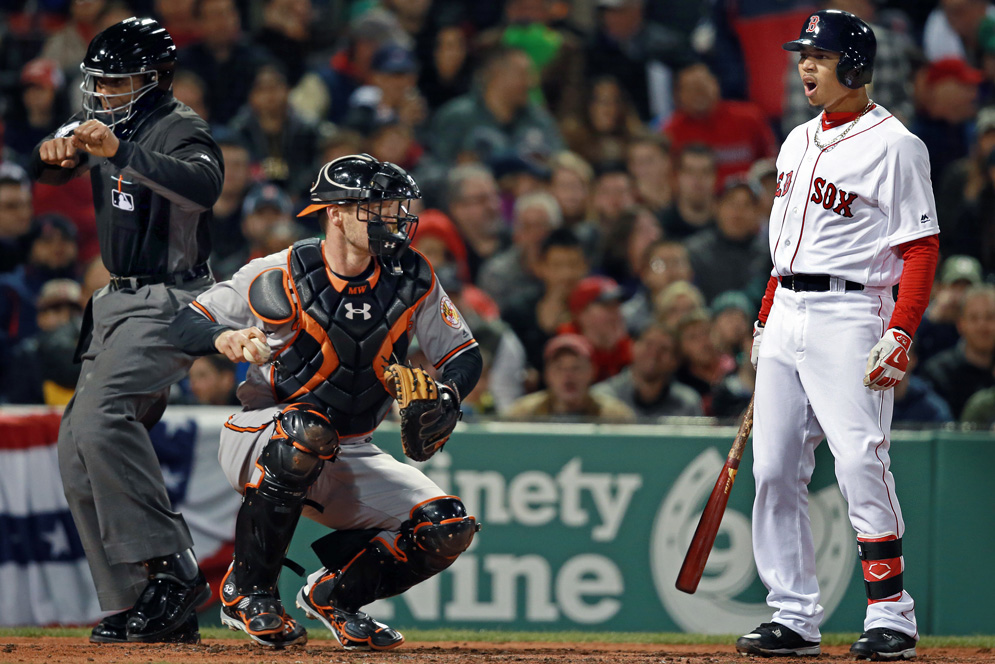MLB has not adopted an electronic strike zone due to tradition and the nuanced judgment calls of human umpires. Many stakeholders value the human element in call decisions.
Baseball, America’s beloved pastime, cherishes its long-standing traditions, perhaps none more so than the role of the umpire. The debate around implementing an electronic strike zone in Major League Baseball touches on the balance between the purity of the game and the advancement of technology.
Fans and players alike often express mixed feelings about the subject. Umpires’ judgment calls are seen as a vital part of the sport’s human aspect, despite growing calls for improved accuracy and consistency that technology could provide. Concerns regarding the technology’s impact on the pace and strategy of the game also play a vital role. The discussion remains ongoing as advancements in technology continue to evolve, bringing the prospect of an electronic strike zone closer to reality. But for now, MLB maintains its traditional method, valuing the unpredictable and subjective nature of the human umpire’s call.
The Tradition Of Human Umpires
The Tradition of Human Umpires in Major League Baseball not only anchors the game in its historic roots but also infuses it with a human element that technology cannot replicate. The debate on whether to implement an electronic strike zone often runs into the deep-seated love for this tradition.
Emotional Core Of Baseball
At the heart of America’s pastime lies the enduring bond between the game and its fans. Umpires, with their unique personalities and imperfections, contribute to the dynamic spectacle of baseball. Their calls often ignite passions, spur debates, and sometimes become as historic as the plays themselves.
Emotional reactions to umpire decisions create unforgettable moments. These moments connect fans, players, and coaches. A robotic strike zone lacks the ability to participate in this emotional exchange. This emotional core is pivotal to the fan experience.
Historical Significance
Human umpires have always been integral to baseball. Their involvement dates back to the game’s inception. This tradition honors the legacy of countless iconic umpires who have shaped the game.
The presence of human umpires connects current play to a storied past. Baseball legends have emerged not only from the ranks of players but also among the officials who called their games. An electronic strike zone could sever this historical continuity.
Each game’s unique narrative weaves into baseball’s rich tapestry. Human judgments and the ensuing dialogues are part of this larger story. They are chapters that fans recount for years to come, highlighting the historical significance of human officiating in MLB.

Credit: www.bu.edu
Accuracy Of Current Umpiring
Modern baseball fans often debate the precision of umpire-made calls. The question invites curiosity: why does Major League Baseball (MLB) stick to traditional umpiring when technology proposes an electronic strike zone? To understand this, let’s assess the accuracy of current umpiring methods.
Inconsistencies In Strike Calls
Umpires face a tall order in maintaining consistency across thousands of pitches. Each has a unique strike zone interpretation. Data shows variability in critical calls, potentially due to factors such as:
- Perspective from behind the plate
- Human reaction time limitations
- Personal judgment of ball speed and trajectory
This inconsistency can lead to disputes and frustrations among players, coaches, and fans alike.
Impact On Game Outcomes
The accuracy of ball and strike calls has a profound impact on game results. Close games can hinge on a single umpire’s decision. An analysis of pivotal games has revealed that:
| Game Situation | Impact of Call |
|---|---|
| Ball vs. Strike in a Crucial At-Bat | Changes the batter’s approach |
| Questionable Strikeout | Can halt potential rallies |
| Close Walk Call | Influences base runners and game tension |
Fans wonder whether consistent electronic systems might better serve the game’s fairness. Despite advancements in technology, MLB continues to value human elements unique to baseball.
Technological Advancements
The debate around the use of electronic strike zones in Major League Baseball (MLB) has been heating up. Technological progress has transformed many aspects of our lives, and sports are no exception. From instant replays to advanced analytics, tech has improved accuracy and the fan experience in many ways. Yet, baseball purists and some players argue against replacing the human element of calling balls and strikes with technology. Let’s delve into what advancements have been made and what they might mean for the future of baseball.
Evolution Of Electronic Systems
Electronic systems in baseball have come a long way. It all started with simple scoreboards and evolved into sophisticated cameras and sensors that can track ball trajectories. Today, systems like Hawk-Eye and TrackMan use high-speed cameras and radar technology to analyze ball movement. These systems provide real-time data that helps not only in training but also in game analysis.
- Initial Systems: Basic electronics for scorekeeping.
- Advancements: Introduction of pitch-tracking technology.
- Current Era: Integration of multiple technologies for precise data.
Accuracy & Reliability
A key argument for electronic strike zones centers on accuracy. Human umpires, while skilled, can make errors. Electronic strike zones promise to significantly reduce these mistakes. Studies comparing human-called strikes versus electronic systems demonstrate a clear improvement in consistency and precision. Furthermore, the technology is continually improving to provide even more dependable results.
- Reduced human error.
- Improved strike-zone consistency.
- Ongoing technological enhancements.

Credit: www.krqe.com
Argument For Electronic Strike Zones
Baseball fans and players often debate over the calls made by umpires. Sometimes, these decisions can change the game. This is why some people talk about having electronic strike zones in Major League Baseball (MLB). Let’s explore the reasons why this could be good for the game.
Fairness And Objectivity
Hitting a baseball is hard. Pitching is tough, too. Players work hard to be accurate. But human umpires can make mistakes. An electronic strike zone means no bias and consistent calls.
- Robots don’t root for a team.
- Every pitch gets judged fairly.
- Players know exactly what to expect.
Efficiency In Decision Making
In baseball, time is important. Fast and correct calls keep the game moving. Electronic zones can help with that. Games could become shorter and more exciting.
Here’s how technology can assist:
- No need for lengthy umpire discussions.
- Instant feedback on pitches.
- Players spend less time arguing calls.
| Without Electronic Zone | With Electronic Zone |
|---|---|
| Possible long delays | Quick decisions |
| Uncertain calls | Consistent rulings |
Opposition To Technology
Some fans and professionals in Major League Baseball oppose introducing an electronic strike zone. They believe that technology could hurt the game. The debate focuses on retaining human judgment versus relying on machines. Let’s dive into the two central reasons why there is hesitation to embrace this technology.
Human Element Philosophy
The essence of baseball includes human decisions. Umpires have always called balls and strikes. This tradition adds a unique character to the game. Many argue that an electronic strike zone would remove the charm that umpire’s rulings bring. Fans and players embrace the suspense and unpredictability of each call.
Fear Of Over-automation
There is a concern that reliance on technology can go too far. Over-automation might take away from the natural flow of the game. Creativity and spontaneity are at the heart of this sport. Too much tech could reduce the importance of human skills and adaptability.
Economics And Implementation
The integration of an electronic strike zone in Major League Baseball (MLB) involves complex economic and implementation challenges. One might wonder why a top-tier league like MLB hasn’t made the switch to technology-assisted calls. Understanding the financial and logistical aspects sheds light on different factors that have restrained MLB from adopting this cutting-edge system.
Cost Of Technology Installation
Installing an electronic strike zone across MLB stadiums is a significant financial investment. Here are key factors driving up the costs:
- High-tech equipment: Each stadium requires state-of-the-art cameras and sensors.
- Infrastructure upgrades: Existing facilities need extensive modifications.
- Uniformity: Ensuring consistency across all venues is essential and expensive.
The large sum required for this technology raises questions about its return on investment.
Training And Maintenance
Post-installation, the real work begins with training personnel and maintaining the system:
| Aspect | Details |
|---|---|
| Training staff | Umpires and technicians must learn to work with the new system. |
| Ongoing support | Technical staff is needed for troubleshooting and repairs. |
| Software updates | Continuous improvements to software require additional resources. |
These steps ensure the electronic system remains reliable game after game.
Purity Of The Sport
The ‘Purity of the Sport’ speaks to the heart of baseball—a game steeped in tradition. Critics of an electronic strike zone argue it could strip away the human element that has defined baseball for over a century. This element involves the relationship between the pitcher, catcher, and umpire, which is as much a part of the game as the crack of the bat.
Baseball’s Unwritten Rules
Baseball is unique with its ‘unwritten rules’—guidelines that players follow, though they’re not in any official handbook. These rules cover sportsmanship, respect, and the subtle nuances of gameplay. Implementing an electronic strike zone would mean altering or disregarding some of these sacrosanct conventions, possibly changing the entire dynamic and strategy of the game.
Fan And Player Reactions
Fans and players often form emotional attachments to the ritual and unpredictability of the umpire’s call. Arguments on the field and heated discussions among fans are part of the drama and passion that make baseball the beloved pastime it is. Implementing an electronic strike zone risks alienating a fan base that revels in the game’s organic ebb and flow.
On the player side, many have voiced concerns about losing the art of pitch framing—a skill catchers use to influence umpire calls. Such modifications to the game could also impact pitchers and batters, who often rely on understanding and adapting to an umpire’s subjective strike zone.
Experimentation And Trials
The journey towards a fully electronic strike zone in Major League Baseball (MLB) brims with rigorous experimentation and trials. Crucial to determining the viability of this technology-driven approach, these phases aim to keep the integrity of the game intact while easing into a potential transformative era for baseball. Let’s delve into how these stages unfold from the lower levels to the biggest stage in baseball.
Minor League Testing
In the minor leagues, the electronic strike zone concept is undergoing extensive testing. This testing ground is essential for smoothing out any kinks. Here the Automated Ball-Strike System (ABS) records its performance:
- Accuracy checks – Are the calls consistent with current standards?
- Player feedback – How do pitchers and batters feel about it?
- Umpire adaptation – How do officials interact with the new system?
This level of professional baseball acts as a crucial stepping-stone, mirroring MLB conditions without the heightened stakes.
Integration Challenges
Bringing an electronic strike zone to the majors is not without its hurdles. The interweaving of technology with tradition presents specific integration challenges:
- Technological reliability – Can the system endure a full season without critical errors?
- Operational training – Are staff fully prepared to implement this change?
- Rules and regulations – How will the new system affect the rulebook?
Addressing these challenges is crucial for a seamless transition that respects the game’s history and embraces its future.
Impact On Umpire Careers
The topic of tech in baseball often stirs debate. What might the impact of an electronic strike zone be on those who call the game from behind the plate? Let’s delve into the ripple effects an e-zone might have on the careers of MLB umpires.
Job Security Concerns
Job security for Major League Baseball umpires has been a comfortable constant. With talk of introducing electronic strike zones, this certainty faces potential disruption. Understanding how technology could change umpiring jobs matters to many.
- Automation impact on traditional roles
- Shifts in required skills and training
- Uncertainty in career longevity
- Adaptation to new technologies
Changing Roles
Umpires contribute more to the game than calling strikes and balls. Their judgment forms a core part of baseball. With the adoption of an electronic strike zone, the role of the umpire would evolve from its current form.
| Current Role | Evolved Role |
|---|---|
| Main decision-maker on strikes | Overseer of electronic calls |
| Call disputes handler | Technology liaison and conflict resolver |
In this new landscape, umpires must become technology savvy. They would still maintain game flow and enforce rules. Their expertise, however, would also include managing an electronic system designed to aid in their decision-making.
The Future Of Mlb Officiating
The Major League Baseball (MLB) landscape bristles with anticipation as the debate around electronic strike zones bubbles up. Fans and players alike wonder: Will technology soon call the shots? The future of MLB officiating stands at a crossroads, marked by tradition and innovation.
Prospects Of Adoption
The introduction of an electronic strike zone promises a blend of fairness and precision. Umpires currently face immense scrutiny over strike and ball calls. An electronic system could lift this burden, ensuring each call hinges on consistent accuracy.
Yet, the question remains: is MLB ready for this shift? Adoption prospects are rising as technology advances. The modern fan’s desire for instant precision nudges the league towards inevitable change. Pilot programs in minor leagues serve as testing grounds, bringing us closer to the day when electronic officiating becomes the norm.
Alternative Innovations
While electronic strike zones present an alluring future, MLB does not ignore other innovations. Radar technology and advanced camera systems already subtly influence the game. Alternative innovations continue to surface, aiming to enhance the human element rather than replace it.
- Smart watches for umpires with instant replay feeds
- Ball-tracking tech for player analysis and training
- Virtual reality systems to simulate decision-making scenarios
Each alternative ranks high on the MLB’s list, exemplifying a commitment to maintain the game’s integrity and excitement. Fans eagerly await how these technologies will reshape their beloved sport.

Credit: www.nytimes.com
Frequently Asked Questions On Why Doesn’t Mlb Use Electronic Strike Zone
Will Mlb Go To Electronic Strike Zone?
As of now, MLB has not fully implemented an electronic strike zone. Experiments with the technology, such as the Automated Ball-Strike system, continue in minor leagues. Full adoption in MLB games remains uncertain and awaits official decisions.
How Accurate Is The Electronic Strike Zone?
The electronic strike zone boasts high accuracy, typically exceeding 90%, thanks to advanced technology and continuous improvements in software algorithms.
Does Aaa Baseball Have An Electronic Strike Zone?
As of my last update, AAA baseball does not universally implement an electronic strike zone. Some individual AAA leagues may experiment with it, but it’s not a standard system across all AAA teams or games.
How Does The Mlb Automated Strike Zone Work?
The MLB automated strike zone employs advanced cameras and sensors to analyze pitches and determine whether they fall within the strike zone, providing a consistent ball and strike calling system for umpires to review and make the final call.
What Is Mlb’s Stance On Electronic Strike Zones?
MLB is currently evaluating electronic strike zone technology but has not fully implemented it in official games, opting to maintain traditional umpire calls for the time being.
Conclusion
Exploring the realm of baseball, we recognize the charm of human judgment in America’s pastime. The MLB’s decision to forego an electronic strike zone balances tradition with technology. It’s a nod to the game’s heritage, ensuring fans continue to relish the debates that arise from every close call.
As the sport evolves, so might the rules, but for now, the umpire’s call remains part of the thrill.


